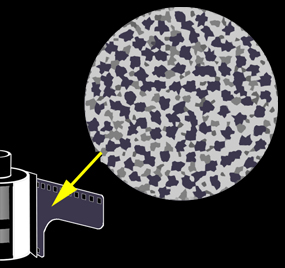Sequence viewing > black & white film - processing Index - Resource - ©
Lloyd Godman
Film
Grain
Grain
Photographic emulsions contain minute grains of silver.
The size and nature of these grains determine the quality
of the final photographic image. Film is only capable of
resolving a certain amount of information per Sq. cm. Therefore
the larger the film size the more information that can be
stored. The conditions, which dictate the size and nature
of the grain, are listed below.

The nature of
the emulsion or the original size of the silver halide crystals
is the most important factor.
The
composition of the developer also control grain. Its chemical
constituents may tend to group individual grains of silver
together, increasing the size of the grain. So-called fine
grain developers are those that will prevent this clumping
of silver particles.
Graininess
increases with development contrast ie. Over development
the longer it is developed the larger the grain size.
Dense
portions of a negative will show up more grain than less
dense areas. Graininess is more noticeable in negatives
that lack sharpness and definition.
Processing
temperatures including that of all chemicals and wash will
influence the grain size. Higher temperatures, the larger
the grain. However too higher temperatures can cause reticulation
where the grains clump together in a crystallized pattern
or separate the emulsion from the base.
Want to learn more? - do a workshop or one on one with Lloyd Godman
|